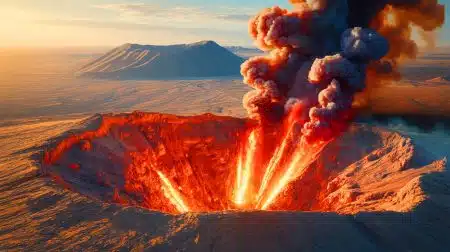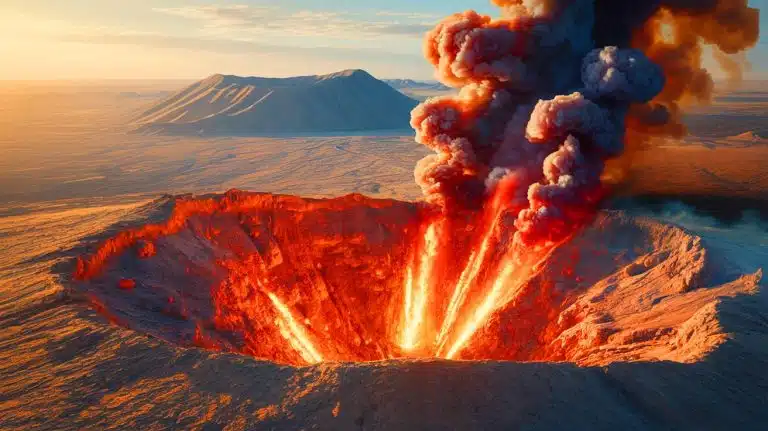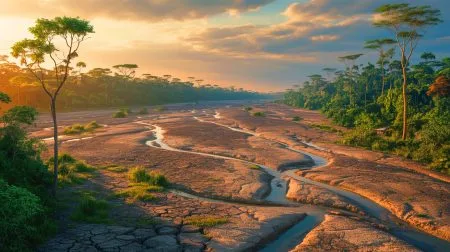| IN A NUTSHELL |
|
In the heart of Turkmenistan’s Karakum Desert, a natural spectacle is drawing to a close. The “Gates of Hell,” a fiery crater known as Darvaza, has been burning for half a century, spewing methane, a potent greenhouse gas. Now, authorities plan to extinguish this infamous blaze. This decision follows years of fascination, attracting tourists like Irina from Ashgabat, who braved hours of rough desert travel to witness the diminishing flames. Despite its allure, the site represents a significant environmental challenge, as Turkmenistan grapples with its role in global methane emissions.
The Environmental Impact of Methane
Methane is a major contributor to climate change, responsible for about 30% of global warming since the industrial revolution. It is far more effective at trapping heat in the atmosphere than carbon dioxide, making its management crucial in efforts to combat climate change. Turkmenistan, despite its smaller size compared to major emitters like the United States and China, holds a record for methane super-emissions, as reported by the International Energy Agency in 2024. The Darvaza crater, although a minor contributor to these emissions, symbolizes the broader environmental challenges faced by the nation.
The decision to extinguish the flames is not just environmentally motivated. Turkmenistan’s economy is heavily reliant on its vast gas reserves. President Gurbanguly Berdimuhamedov, in a move to protect both the environment and the nation’s economic interests, ordered the crater to be put out, citing the loss of valuable resources that could otherwise benefit the country’s population. The potential for gas export profits presents a compelling economic incentive to address the ongoing combustion.
Challenges in Extinguishing the Flames
The effort to control the Darvaza crater is fraught with challenges. Turkmenistan's state-run company, Turkmengaz, has reported success in reducing the intensity of the flames by over threefold. However, the unique geological makeup of the Karakum Desert complicates their efforts. The desert's subsurface is characterized by numerous thin layers of hydrocarbons interspersed with dense, water-containing strata. This geological complexity has prolonged the crater's combustion, as these layers continue to supply the fire with fuel.
Despite the progress reported by Turkmengaz, the task is far from straightforward. The company aims to completely isolate the crater's surface once the gas flow diminishes, thereby halting uncontrolled emissions. The lack of transparency and accessibility to Turkmengaz's operations, however, raises questions about the feasibility and accuracy of these claims. Information is tightly controlled by the Turkmen authorities, making independent verification difficult.
A Blow to Local Tourism
The Darvaza crater has been a unique tourist attraction since its accidental creation in 1971 by Soviet geologists. Anatoly Bouchmakine, a 90-year-old Turkmen scientist, recalls how the initial accident led to the continuous burning of the site. While the incident provided valuable insights into the gas reserves of the region, it also established an iconic landmark in an otherwise isolated country.
The potential closure of Darvaza presents significant challenges for Turkmenistan's nascent tourism industry. The country, largely covered in desert, offers few tourist attractions compared to its neighbors. For the limited number of foreign visitors able to secure visas, the fiery crater is a must-see destination. Local travel agencies, like the one employing Ovez Mouradov, fear the economic impact of losing such a draw. As he notes, the cessation of the flames could lead to significant revenue losses for many tourism-dependent businesses.
The Future of Turkmenistan's Environment and Economy
The decision to extinguish the Darvaza crater reflects Turkmenistan's balancing act between environmental responsibility and economic necessity. The country's leadership must navigate the challenges of reducing methane emissions while maximizing the economic benefits of its natural resources. This initiative could signal a shift towards a more sustainable approach to resource management, aligning with global efforts to mitigate climate change.
However, the opacity surrounding Turkmenistan's environmental policies and industrial practices complicates assessments of progress. As the country takes steps to address its environmental impact, both the local and international communities will be watching closely. The Darvaza crater, once a fiery symbol of environmental negligence, may yet become a testament to Turkmenistan's commitment to a sustainable future. Will this initiative pave the way for broader environmental reforms in Turkmenistan?
Did you like it? 4.5/5 (24)







Is it really possible to put out a fire that’s been burning for 50 years? 🤔
Wow, it’s the end of an era! I always wanted to visit the “Gates of Hell” 🔥. Does this mean no more fiery selfies?